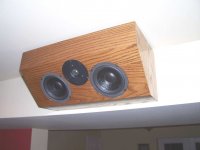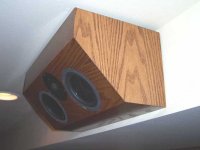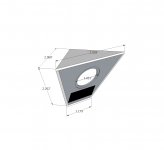sure horns work good but i already have the speakers and i am trying to deside if it would be better to mount them or leave them as is.
It would be a whole lot easier if you soffit mounted them away from the corner, worth a try and you wouldn't need any correction
It would work up until the wavefront doesn't cooperate with the room corner. The design process is involved. Why don't you put the speaker in the corner and work from there. Your tools will be the soffit itself -- extension/translator, however you want to see it, can try to make it fit.up to what frequency should i expect a boost?
It would be a whole lot easier if you soffit mounted them away from the corner, worth a try and you wouldn't need any correction
width is not enough.besides correction is no problem.only the early reflections.
It would work up until the wavefront doesn't cooperate with the room corner. The design process is involved. Why don't you put the speaker in the corner and work from there. Your tools will be the soffit itself -- extension/translator, however you want to see it, can try to make it fit.
i was planning to do that to see how it sounds.just waiting for a friend to come move around the furniture.
These are some of the first speaker I built. Curt Campbell's Triune.
TriuneTL_07
They are still in use for my wife's HT setup as surrounds
TriuneTL_07
They are still in use for my wife's HT setup as surrounds
Attachments
yes but the result is the same.any way the answer to my question must be something like the closer the drivers in the corner the higher the frequency it takes effect?any idea how to calculate?
The effect is 3dB per boundary, not 6dB
Try:
Loudspeaker Design Software
or use a BEM simulator.
These are some of the first speaker I built. Curt Campbell's Triune.
TriuneTL_07
They are still in use for my wife's HT setup as surrounds
Nice, but why is the tweeter off-axis?
Curt designed these as main speakers and as a center channel. The off center tweeter will help with the diffraction signature of the vertical MTM main speakers. The tweeter offset carried over to the horizontal configuration.
Here is a concept to consider. Its a SEOS12 and compression driver with a 12" woofer structured to aim down from a ceiling corner. I never built it; I got interested in Synergy horns instead. If you did build it you would probably want absorbers on the walls and ceiling immediately adjacent to the cabinet. There is enough cabinet volume there for bass reflex so with the right woofer you could have response down to ~40 Hz.
Something else to consider would be Bwaslo's Small Syns built into a box shaped like this but that would mean taking on a more complex crossover
Something else to consider would be Bwaslo's Small Syns built into a box shaped like this but that would mean taking on a more complex crossover
Attachments
These are some of the first speaker I built. Curt Campbell's Triune.
TriuneTL_07
They are still in use for my wife's HT setup as surrounds
did they sound good as main speakers?
yes you are right.
did they sound good as main speakers?
10 years ago they did 🙂 I've listen to and built many more since then. Today there are better tweeters for the same money. From a sensitivity aspect they are wonderful surrounds.
Using a boundary to halve the radiation space.. achieving the same pressure, power will be down -3dB, but with the same power into half the space the pressure will be up +6dB.The effect is 3dB per boundary, not 6dB
- Status
- Not open for further replies.
- Home
- General Interest
- Room Acoustics & Mods
- corner soffit mount speakers




